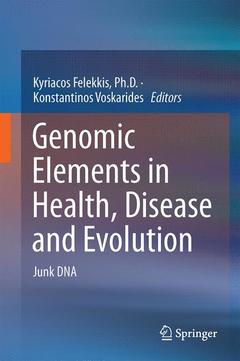Description
Genomic Elements in Health, Disease and Evolution, Softcover reprint of the original 1st ed. 2015
Junk DNA
Coordinators: Felekkis Kyriacos, Voskarides Konstantinos
Language: English
Subjects for Genomic Elements in Health, Disease and Evolution:
Publication date: 10-2015
Support: Print on demand
Publication date: 08-2016
Support: Print on demand
Description
/li>Contents
/li>Comment
/li>
Chapter 1 MiRNAs’ Function and Role in Evolution: Under the View of Genomic Enhancement Phenomena
Konstantinos Voskarides and Kyriacos Felekkis
Chapter 2 MicroRNAs in Disease
Gregory Papagregoriou
Chapter 3 piRNAs- Transposon Silencing and Germ Line Development
Catherine Demoliou
Chapter 4 Long Non-Coding RNA
Monika Gullerova
Chapter 5 Unveiling Transposable Elements Function to Enrich Knowledge for Human Physiology and Disease Pathogenesis
Ioannis S. Vizirianakis, Elsa P. Amanatiadou, and Sotirios S. Tezias
Chapter 6 Copy Number Variation in Human Health, Disease and Evolution
Carolina Sismani, Costas Koufaris, and Konstantinos Voskarides
Chapter 7 Mini- And Micro-Satellite Markers in Health, Disease and Evolution
Vasiliki A. Galani, Sofia Markoula, Leandros Lazaros, Paris Ladias, Ioannis Georgiou
Chapter 8 Intron Biology, Focusing on Group II Introns, the Ancestors of Spliceosomal Introns
María Dolores Molina-Sánchez, Rafael Nisa-Martínez, Fernando M. García-Rodriguez, Francisco Martínez-Abarca, Nicolás Toro
Chapter 9 Centromeres in Health, Disease and Evolution
Thian Thian Beh and Paul Kalitsis
Chapter 10 Structure and Functions of Telomeres in Organismal Homeostasis and Disease
Penelope Kroustallaki and Sarantis Gagos
Chapter 11 Proximal Regulatory Elements with Emphasis on CpG Rich Regions
Pavlos Fanis
Chapter 12 Genomic Analysis through High-Throughput Sequencing
Michalis Hadjithomas
Includes information and novel functions about all the known genomic elements in a single publication
Discusses the physiologic function of these elements their role in disease and evolution
This book is dedicated exclusively to non-coding genomic elements
Includes supplementary material: sn.pub/extras




